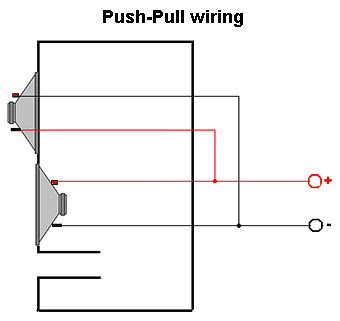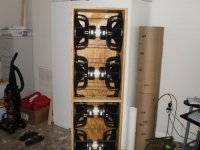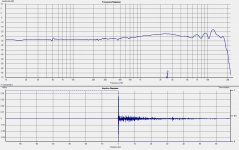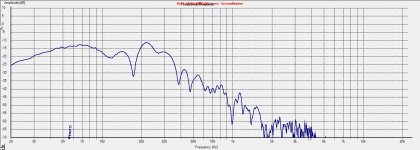Eighteen Sound have a dual 21 inch manifold design , interesting that they do not couple the two drivers. Worth a look. Best regards Moray James.
http://www.eighteensound.com/staticContent/applications/kits/18Sound_kit_dual21_ Prel.pdf
http://www.eighteensound.com/staticContent/applications/kits/18Sound_kit_dual21_ Prel.pdf
"what tweeter this is?"
SEAS H253
Thanks
it has no label anymore, but it sounds sweet, so why I did ask.
18 sound dbl manifold
I don't care for the face-to-face mounting at all. If anything, a magnet to magnet coupling to cancel forces. Below 80hz for sub use only. Those huge 21 inchers have too high an Fs to be considered subs (in my opinion).
Here's how I did mine. The pic is BEFORE being installed in the Infinite baffle system.
Eighteen Sound have a dual 21 inch manifold design , interesting that they do not couple the two drivers. Worth a look. Best regards Moray James.
http://www.eighteensound.com/staticContent/applications/kits/18Sound_kit_dual21_ Prel.pdf
I don't care for the face-to-face mounting at all. If anything, a magnet to magnet coupling to cancel forces. Below 80hz for sub use only. Those huge 21 inchers have too high an Fs to be considered subs (in my opinion).
Here's how I did mine. The pic is BEFORE being installed in the Infinite baffle system.
Attachments
Scott,I don't care for the face-to-face mounting at all. If anything, a magnet to magnet coupling to cancel forces. Below 80hz for sub use only. Those huge 21 inchers have too high an Fs to be considered subs (in my opinion).
The 18 Sound 21" drivers have an Fs of 28 and 29 Hz, lower than the drivers elsewhere in this thread.
Sub means "below", the 35 Hz LF corner of the 18 Sound "Manifolded Double 21 Bandpass Subwoofer Kit" is well below most "full range" speakers.
As far as canceling vibration forces, face to face, magnet to magnet, or push pull (magnet to cone) are all equally effective. Your infinite baffle system could have reduced even order harmonic distortion had you used push- pull mounting.
18 Sound drivers have a fair amount of magnet structure heat vent noise when close to Xmax, magnet to magnet mounting would allow that noise to be heard, while the cabinet design with the cones both facing in to the manifold plenum dampens that noise.
Art Welter
The drivers are coupled in a large manifold plenum, though not push pull mounted.Eighteen Sound have a dual 21 inch manifold design , interesting that they do not couple the two drivers. Worth a look. Best regards Moray James.
http://www.eighteensound.com/staticContent/applications/kits/18Sound_kit_dual21_ Prel.pdf
When the driver's heat vent noise is objectionable (as in 18 Sound speakers), it may be worse sounding to have the driver's vent "in the open" than the even order harmonic distortion reduction PP reduces.
Art Welter
http://www.seas.no/images/stories/vintage/pdfdataheet/h253_1_dome.pdf Boston Acoustic used these in a variety of models for many years, they do sound pretty good.
Regards vent noise:
The original drivers I designed the PPSL around had no pole vents, they had a large felt dustcap and were dead quiet.
For hi-fi the driver under consideration should be evaluated for vent noise. Linkwitz discusses this on his PPSL design H-frame subwoofer, he found considerable differences in drivers that looked similar.
"Some drivers may buzz due to marginal attachment of the magnet assembly to the basket. This is difficult to determine before the dipole woofer is completed. To avoid this, apply a heavy bead of Silicone II Sealer & Glue to the gap between magnet and basket. "
"A driver with Xmax = 12 mm will generate quite a bit of aerodynamic noise, i.e. distortion, at such high excursions. The space behind the spider needs to be open to the outside to minimize noise. The pole piece should have a large vent, or the cone should have no dust cap, so that air trapped behind the dust cap does not contribute noise.
For a qualitative evaluation of a new woofer perform a simple test. Put a dot of white paint on the cone or dust cap to monitor excursion. Connect the driver to a power amplifier and drive it from a signal generator set to 35 Hz. Hold the unbaffled driver in your hands. Increase the generator output and observe how quiet the driver remains and how much excursion it can handle before sounding obnoxious. Remember that an open baffle cabinet will not attenuate this noise. Lower the frequency and repeat the test. Be careful not to overheat the voice coil or to destroy the driver mechanically!! The burst capability of the Agilent 33120A Arbitrary Waveform Generator is wonderful for this work. Unfortunately, the majority of drivers that I have evaluated required no further investigation after this test. "
"The major problem with increased excursion is the disproportionate increase in aero-dynamic noise. It is generated by the turbulent flow of air in and out of the magnet vent and by the air trapped behind the spider if it is not completely vented. The typical, low cost stamped basket design is not suited for venting the spider. The extraneous noise becomes especially noticeable in an open baffle speaker, because it contains many high frequency spectral components and is intermodulated with the desired signal."
For PA I did have a problem with some magnets making 'clanking' or 'clicking' noise as per above, I ran a bead of adhesive between the top-plate of the magnetic assembly and the frame and that fixed it.
Regards vent noise:
The original drivers I designed the PPSL around had no pole vents, they had a large felt dustcap and were dead quiet.
For hi-fi the driver under consideration should be evaluated for vent noise. Linkwitz discusses this on his PPSL design H-frame subwoofer, he found considerable differences in drivers that looked similar.
"Some drivers may buzz due to marginal attachment of the magnet assembly to the basket. This is difficult to determine before the dipole woofer is completed. To avoid this, apply a heavy bead of Silicone II Sealer & Glue to the gap between magnet and basket. "
"A driver with Xmax = 12 mm will generate quite a bit of aerodynamic noise, i.e. distortion, at such high excursions. The space behind the spider needs to be open to the outside to minimize noise. The pole piece should have a large vent, or the cone should have no dust cap, so that air trapped behind the dust cap does not contribute noise.
For a qualitative evaluation of a new woofer perform a simple test. Put a dot of white paint on the cone or dust cap to monitor excursion. Connect the driver to a power amplifier and drive it from a signal generator set to 35 Hz. Hold the unbaffled driver in your hands. Increase the generator output and observe how quiet the driver remains and how much excursion it can handle before sounding obnoxious. Remember that an open baffle cabinet will not attenuate this noise. Lower the frequency and repeat the test. Be careful not to overheat the voice coil or to destroy the driver mechanically!! The burst capability of the Agilent 33120A Arbitrary Waveform Generator is wonderful for this work. Unfortunately, the majority of drivers that I have evaluated required no further investigation after this test. "
"The major problem with increased excursion is the disproportionate increase in aero-dynamic noise. It is generated by the turbulent flow of air in and out of the magnet vent and by the air trapped behind the spider if it is not completely vented. The typical, low cost stamped basket design is not suited for venting the spider. The extraneous noise becomes especially noticeable in an open baffle speaker, because it contains many high frequency spectral components and is intermodulated with the desired signal."
For PA I did have a problem with some magnets making 'clanking' or 'clicking' noise as per above, I ran a bead of adhesive between the top-plate of the magnetic assembly and the frame and that fixed it.
Last edited:
What kind of question ?
Consider the title: A Thread for those interested in PPSL enclosures
Consider reading from post #1
OK, whatever-phase, what's the benefit over face to face mount?
Consider the title: A Thread for those interested in PPSL enclosures
Consider reading from post #1
Look this is clear, I see, like you all say calculate for a vented box, I presume the pipes have to big enough just to make not hear the air going in and out.
here I have a plot from my H frame, line level corrected, yes offtopic for a moment, but I want to make the PPSL so I stick here for a while, The slot has I also did read so small as the magnet conus of the driver kan be without touching each other, strange that two woofers are connected what does other normal boxes loose bass because of opposite fase, strange design and box who works with compression-decompression as I think I see, yes I am green behind the ears..
Attachments
Last edited:
Hi Kees,
The plenum (cavity) makes it look more difficult than it actually is. You can even leave the plenum out if you want (see picture) but that lowers the functioning of the Push-Pull as frequency rises.
The trick behind PP(SL) is that drivers have different (electrical and mechanical) properties between moving forwards and backwards. By flipping around one driver you can eliminate part of these differences, that otherwise would lead to non-linear movement (distortion).

Edit: This picture is only Push-Pull and not Push-Pull Slot Loaded... ;-) Sorry for the title...
The plenum (cavity) makes it look more difficult than it actually is. You can even leave the plenum out if you want (see picture) but that lowers the functioning of the Push-Pull as frequency rises.
The trick behind PP(SL) is that drivers have different (electrical and mechanical) properties between moving forwards and backwards. By flipping around one driver you can eliminate part of these differences, that otherwise would lead to non-linear movement (distortion).

Edit: This picture is only Push-Pull and not Push-Pull Slot Loaded... ;-) Sorry for the title...
Last edited:
Hi Kees,
The plenum (cavity) makes it look more difficult than it actually is. You can even leave the plenum out if you want (see picture) but that lowers the functioning of the PPSL as frequency rises.
The trick behind PP(SL) is that drivers have different (electrical and mechanical) properties between moving forwards and backwards of the cone. By flipping around one driver you can eliminate part of these differences, that otherwise would lead to non-linear movement (distortion).

Hi Djim
I have no problem with the difficulties about the enclosure itself but how it is designed technical speaking, but you give me now a very good explanation about it, the total volume looks like designed as vented box with as extra a plenum.
I have try with software the visatons but a port of 2.30 meter is a little long, so I think that software has a to long equation.
in your example I see the drivers are in fase, with a plenum she are connected out fase, or see I something wrong.
Yes I am green behind the bla bla I am a amp designer, loudspeakers are new for me, so hard learning.
oke, thanks en een goede avond nog.
Last edited:
Your welcome. Yes its just a basreflex (or another enclosure type if you want) with two drivers and a plenum. If you make the basreflex-port(s) too long they will have a resonance in the subrange that you want to prevent. Try to keep the length of the port(s) below 80cm.
When you use WinSID (free software) you can model basreflex and see the resonance of the port.
(prettig weekend)
When you use WinSID (free software) you can model basreflex and see the resonance of the port.
(prettig weekend)
Last edited:
Your welcome. Yes its just a basreflex (or another enclosure type if you want) with two drivers and a plenum. If you make the basreflex-port(s) too long they will have a resonance in the subrange that you want to prevent. Try to keep the length of the port(s) below 80cm.
When you use WinSID (free software) you can model basreflex and see the resonance of the port.
(prettig weekend)
Dank je wel.
Oke, I wil try that.
Ik test net de H frames, wel hij gaat vlot naar 30 hz en lager alles rammelt hier maar he beperkte luidheid, maar ja het een of het ander.
I like the PPSL for testing, I have the martin sheets for testing the visatons WSP26S I do use for the tests, it are very good interesting woofers, the PPSL looks like a dipole, you say a vented box but there is more these box go low with a high efficienty as i did read because horns are involved as mid high.
groet
In PA it is not uncommon to use two acoustic loads, each one loading one side of the driver. They do this in order to gain output level or to expand the bandwidth, BUT at cost of distortion.
For HiFi I wouldn’t recommend such system as it will introduce more THD. What you want for high quality sound is a minimum amount of system resonances.

(tis altij 't-een of 't-aander )
)
For HiFi I wouldn’t recommend such system as it will introduce more THD. What you want for high quality sound is a minimum amount of system resonances.

(tis altij 't-een of 't-aander
- Status
- This old topic is closed. If you want to reopen this topic, contact a moderator using the "Report Post" button.
- Home
- Loudspeakers
- Subwoofers
- A Thread for those interested in PPSL enclosures



